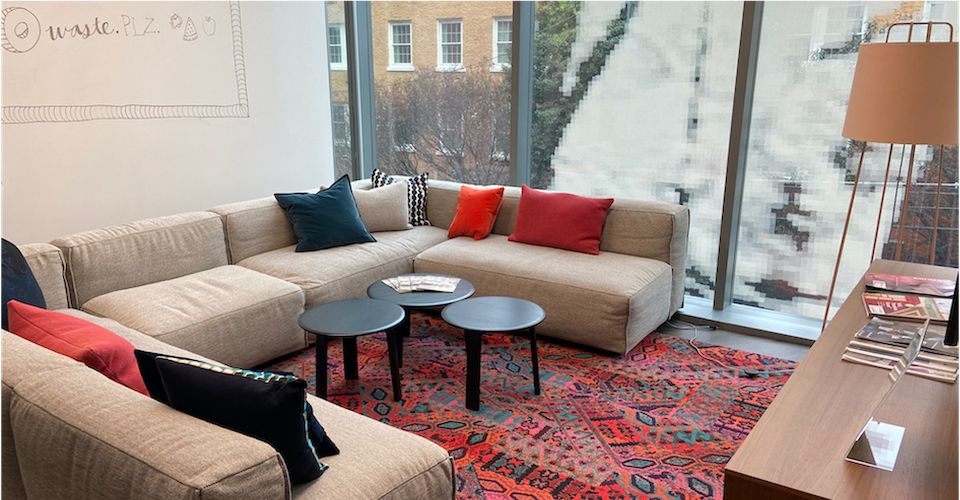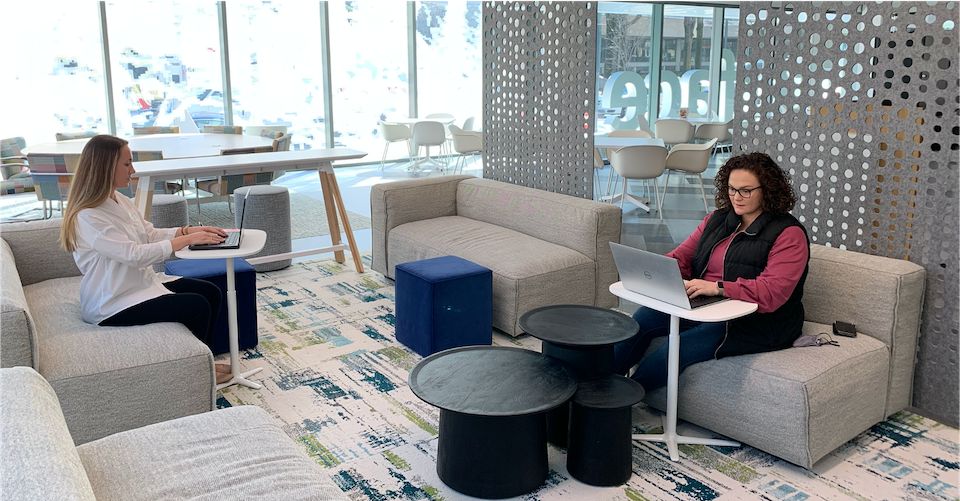In March 2020, the U.S. population’s behavior and day-to-day life changed overnight. As we put on masks, worked from home and acquainted ourselves with Microsoft Teams and Zoom, we faced questions about what our return to the office might look like, how it will occur, and how our workspaces might change.
During our Base Camp redesign project, as we’ve gathered data, evaluated the space and identified a design strategy, we’ve kept one consideration top of mind: our people.
When we first surveyed Base Campers about returning to the workplace, we knew we had to take steps to help people feel comfortable coming back; from establishing protective measures to ensuring individuals exposed to COVID-19 remained away from the office environment to installing touchless figures, safeguarding both physical and psychological safety were paramount.
Notably, our employees wanted to return to Base Camp because they missed socializing, being close to team members and spontaneous face-to-face collaboration. This kind of human connection and community gathering was a core objective when we opened Base Camp’s doors in the fall of 2018.
As we began the refresh process, we knew that protecting the integrity of the space, particularly the opportunity for safe interaction and collaboration, would be key. Similarly, we knew that the layout and aesthetic of the space needed to support our collaborative, purpose-driven culture.

Creating areas for safe collaboration was an important part of our Base Camp redesign.
Collaboration is Essential
At Interface, we believe that having a gathering place is essential for our internal culture, innovation and overall business. Base Camp positively contributes to the health and productivity of our organization, leading to collaboration, which spurs innovation. Recognizing that we eventually would ask employees to return to the office, we worked to ensure that everyone viewed Base Camp as a safe, comfortable space that prioritized employee physical and mental well-being.
With this in mind, as we examined Base Camp, we focused on communicating how we would adapt the space with safety in mind, while also creating a workspace equipped for the future beyond the pandemic. We aimed to help employees feel safer and actually be safer when they are at Base Camp. In turn, we hoped to provide the opportunity for our people to prepare for, adapt to and get excited about the changes to come.
Establishing Communication Channels
Once the initial work-from-home dust settled, we knew employees had questions and concerns about the future of work. And, while employees were unable to return for the first few months after our office emptied, we realized the time would come when they would start trickling in again.
To prepare for this moment, we had to understand what employees needed from the space, and how we could safely reopen our facilities to a larger group. As we began these conversations and gauged comfort levels, we held town hall meetings to provide Base Camp updates, generate thought starters and open communication channels. Our efforts included conducting an internal survey to better understand employee perspectives and concerns.
Through this survey and our town halls, we identified pain points for returning to the office and provided transparency in the work required to update Base Camp.
Our survey also revealed that our employees feel productive working from home, citing daily commutes, Base Camp distractions and a lack of quiet space as hindrances in the office. And, 84% of employees believe that their work isn’t dependent on them being in the office.
Given these insights, we introduced one of our first changes to the ways our people work: a flexible and practical telecommuting policy, offering our employees the option to come into the office based on the nature of their work during a particular day or week. Similarly, depending on the day, they are able to work remotely.
As the pandemic becomes less of a threat, we continue to communicate with our people so they can make the safest decisions for their health and the health of their families. With our telecommuting policy providing flexibility, our employees can evaluate their personal comfort level in returning to the office on an ongoing basis and structure their schedules accordingly.
For those employees that opt to come into the office, we outfitted Base Camp with social distancing and safety reminders. These visual cues included sanitation wipe locations, signs and handouts throughout the space to prompt social distancing, hand washing, cleaning and wiping. They also communicated best practices for meetings and moving around the space – a constant reminder to prioritize the well-being of oneself and others.

Our new Ways of Working at Base Camp support social distancing.
Identifying New Ways of Working
With these adjustments, we continue to keep Base Camp open, and as we see case counts decrease and vaccinations increase, we gently encourage more employees to come back to Base Camp as they are able.
In pursuing a redesign plan that fit the specific needs and resources of Base Camp, we knew our employees would need to support the design changes by adapting their workplace behavior.
So, while we ideated on what the future of our office looked like, we also made people aware of these changes and what they might mean for them. These behavioral changes align with the three-pronged approach we took to redesigning Base Camp: Design and Configuration, Technology and Ways of Working.
The design changes and technology enhancements naturally encourage employee behavioral changes, or new Ways of Working, that also support social distancing. Here are examples of how Base Camp’s Ways of Working will change in coordination with the Design and Tech updates:
- Free-Address For All: The majority of Base Camp employees moved to “work-choice” or free address status, which means they are able to choose where they spend their time at Base Camp based on the requirements of their day. They can reserve a workstation with double-monitors for quiet, focused work, or settle into comfy open-air lounge seating as they transition between meetings.
- Neighborhoods: For the time being, each department and team is spending the majority of their day on a specific assigned floor. Employees are welcome to transition between spaces for meetings, but in the short term, we’ll intentionally reduce movement in the building.
- Traffic Management: Base Camp’s refreshed flooring design indicates social distancing demarcation, wayfinding and traffic flow to subtly move people around the space.
- Workspace Reservations: Supporting all of our design updates is the adoption of a system that allows employees to reserve a desk near coworkers and maintain a safe social distance. It also allows Base Camp to scale capacity without impacting design or budget.
These behavioral changes help make Base Camp safe for employees while continuing to prioritize our culture, innovation and exemplification. Our redesigned Base Camp allows employees to stay connected, reflecting how we value in-person face-to-face interaction between colleagues. And, as collaboration is easier in person, we know this will nurture our innovation efforts while keeping our people enthused about their work.
2 responses to “Reapproaching Base Camp: Putting Our People First”
This is good stuff, as usual from Interface. Taking the lead in re-thinking work environments.
I’m with you Ray!